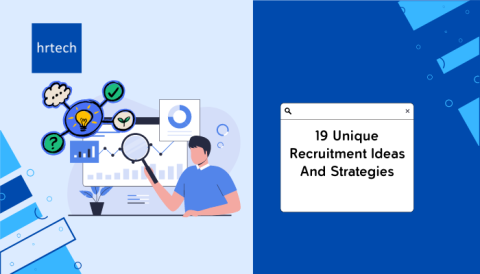Applicant Tracking Solutions for Education and Hospitality
Education and hospitality are industries where it’s important to hire professionals with a very unique skillset. Hiring great people can feel like finding a needle in a haystack—especially if you’re running a school or managing a hotel.
The education sector needs passionate teachers who genuinely connect with students, while hospitality is all about hiring folks who can make guests feel right at home.
Different industries, sure, but both can agree that traditional hiring methods are exhausting. How many hours have you spent buried in resumes or chasing down references, wishing there was an easier way to spot the right fit?
An applicant tracking system (ATS) helps you easily manage all aspects of your hiring. But not all tracking systems are built the same. Education and hospitality have unique hiring challenges that generic tools can’t always solve.
In this blog we will discuss some of the best applicant tracking solutions for the education and hospitality sector.
What is an Applicant Tracking System (ATS)?
An applicant tracking system (ATS) is a software tool that helps you manage the entire hiring process in one place. From posting job openings to reviewing applications and scheduling interviews, an ATS keeps everything organized and easy to track.
Instead of juggling emails, spreadsheets, and paperwork, recruiters can use an ATS to see all applicants, their qualifications, and where they are in the hiring pipeline. It saves time by automatically sorting resumes, highlighting the most suitable candidates, and even sending out follow-up emails.
Think of it as a smart assistant for hiring—one that never misses a detail, keeps things running smoothly, and helps businesses make faster, better hiring decisions.
Here are some common features of an ATS:
- Job Posting Integration: ATS platforms often allow you to post job openings directly to multiple job boards and career pages at once. This saves time and ensures wider reach.
- Resume Parsing: This feature automatically reads and extracts information from resumes, organizing candidate details into a structured format so recruiters don’t have to do it manually.
- Candidate Database: An ATS stores all applicant information in one searchable database, making it easy to revisit past candidates for new roles.
- Application Screening and Filtering: You can set keywords or criteria to filter out unqualified applications, so only the most relevant candidates make it to your shortlist.
- Interview Scheduling: Many systems come with built-in calendar tools or integrate with existing calendars, allowing seamless scheduling of interviews with just a few clicks.
- Communication Tools: ATS platforms often include email templates, automated responses, and communication tracking to keep candidates updated and engaged throughout the hiring process.
- Reporting and Analytics: Track metrics like time-to-hire, source of applicants, and stage-wise drop-off to refine your recruitment strategy using data-driven insights.
- Team Collaboration: Hiring teams can leave notes, rate candidates, and collaborate directly within the system—no more long email threads or missed feedback.
Also Read: “Best Applicant Tracking Systems in 2025”.
We’ve discussed the features of ATS, however, it’s important to understand what benefits ATS can bring to your organization. Let’s take a closer look at the benefits of using an ATS.
Benefits of Using ATS
An Applicant Tracking System (ATS) simplifies and strengthens the hiring process across roles and industries.
Here’s how it adds value:
- Cuts down time spent on manual screening.
- Highlights top candidates based on set criteria.
- Keeps all applications organized in one place.
- Speeds up hiring for time-sensitive roles.
- Helps teams to review and comment in sync.
- Adapts to specific needs—like licenses or soft skills.
- Sends automated updates to keep applicants engaged.
- Supports reporting and compliance with ease.
While these are some common benefits of ATS, let’s understand some unique hiring needs for the education sector and ATS tools suitable for the education sector.
Unique Hiring Needs for Education Sector
Hiring in education is high-stakes—you’re not just filling a role, but choosing someone who will shape young minds and influence the future. Whether it’s a teacher, administrator, or support staff, each role demands more than a resume can show.
Here’s what you should check before hiring in education sector:
- Certification and Qualifications: Ensure that the candidates have the appropriate degrees, certifications, and licensure specific to their teaching field or administrative role.
- Experience with Diverse Student Populations: You should check the ability to work with students from various backgrounds, including those with different learning needs and abilities.
- Cultural Fit: You should find candidates who align with the institution’s values, mission, and commitment to fostering a positive learning environment.
- Passion for Teaching: You should assess candidates’ dedication to inspiring and nurturing students, often seen through personal statements, references, or interview responses.
- Classroom Management Skills: You should also consider the candidates’ ability to handle diverse classroom dynamics and create a productive, engaging space for learning.
- Strong Communication Skills: Both verbal and written communication are key for engaging students, parents, and colleagues effectively.
- Compliance with Education Laws: You should ensure candidates meet regulatory requirements and stay updated on educational policies and procedures.
- Commitment to Professional Development: You should try to identify candidates who are eager to continue learning, grow their skills, and adapt to new teaching methodologies and technologies.
Now let’s take a look at some of the best ATS that can help you easily recruit for your educational institution.
5 Best Applicant Tracking Solutions for Education
Educational institutions face unique hiring challenges like seasonal staffing needs and strict compliance requirements. Whether it’s hiring teachers, administrative staff, or support personnel, the process needs to be fast, organized, and fair.
The right Applicant Tracking System can make all the difference by simplifying recruitment and helping schools attract top talent efficiently.
1. GoHire
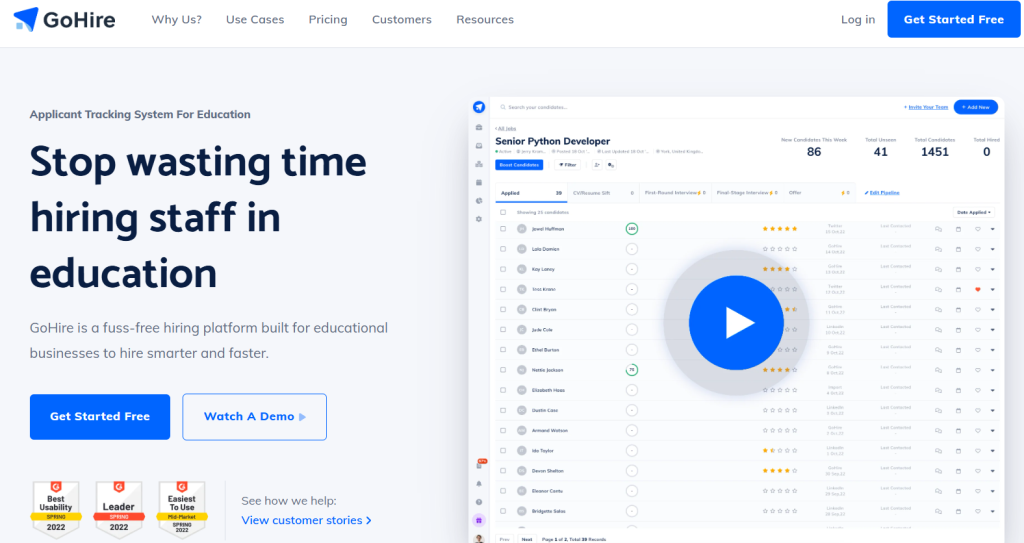
GoHire is an intuitive applicant tracking system (ATS) designed to simplify and streamline the hiring process for educational institutions. By consolidating job postings, candidate management, and interview scheduling into a single platform, GoHire aims to reduce the complexities associated with recruitment in the education sector.
Its user-friendly interface ensures that schools and universities can efficiently attract and manage top talent.
GoHire has a rating of 3.7 out of 5 on G2.
Features
Here are some key features of GoHire:
- Multi-Job Board Posting: Publish job openings across various platforms like Indeed and LinkedIn with a single click, maximizing reach to potential candidates.
- Automated Candidate Screening: Efficiently filter and shortlist applicants based on predefined criteria, ensuring only the most suitable candidates are considered.
- Interview Scheduling: Coordinate and schedule interviews seamlessly within the platform, reducing back-and-forth communication.
- Talent Pools: Maintain a database of past and present applicants, allowing for quick access to potential candidates for future openings.
- Employer Branding Tools: Enhance your institution’s career page to attract high-quality applicants and showcase organizational culture.
Pros and Cons
Here are some pros and cons of GoHire:
| Pros | Cons |
| Centralized candidate management system. | Limited advanced reporting features. |
| One-click job posting to multiple job boards. | Integration with some HR tools can be less seamless. |
| Easy-to-use and beginner-friendly interface. | Customer support may be slow or inconsistent, per reviews. |
2. Pinpoint
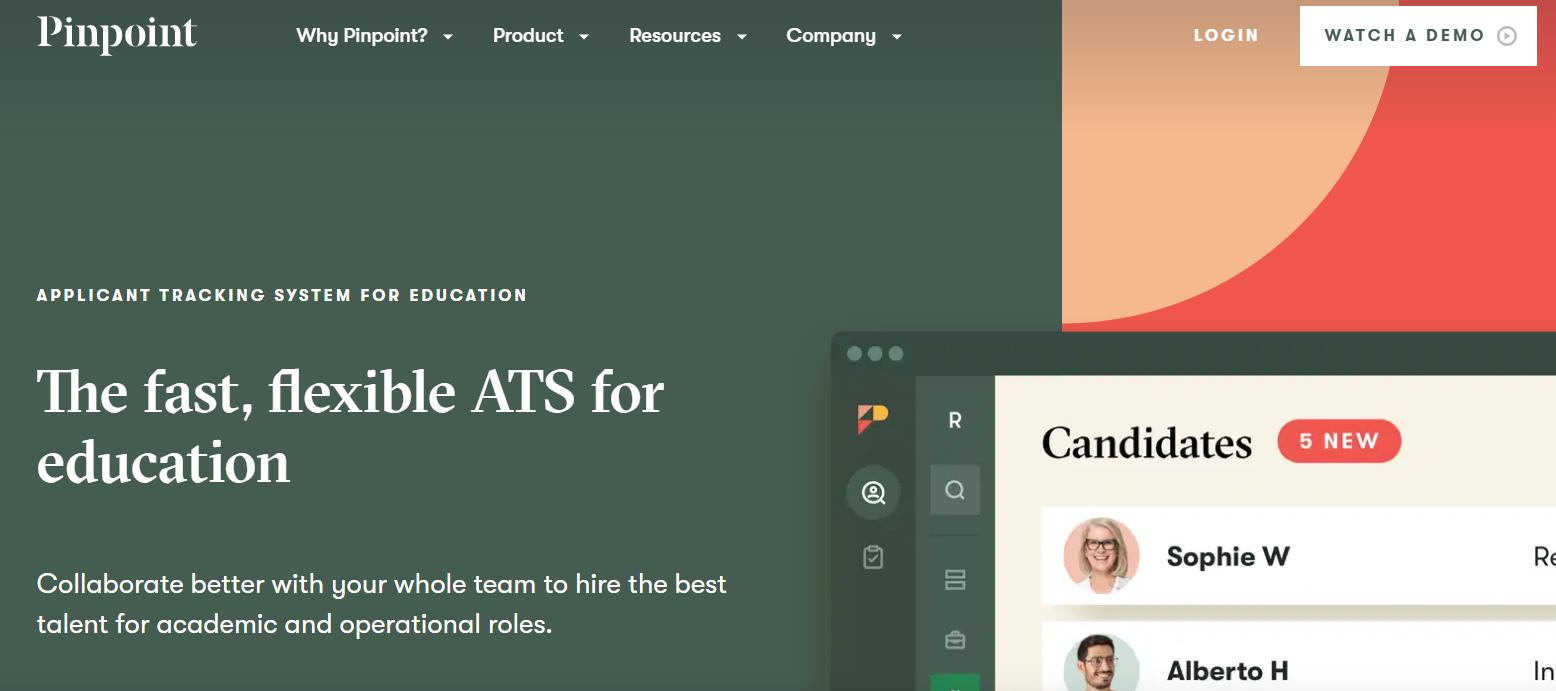
Pinpoint is a flexible and user-friendly applicant tracking system (ATS) designed to streamline the hiring processes of educational institutions. It offers tailored solutions that facilitate collaboration among hiring teams, ensuring efficient recruitment for both academic and operational roles.
Pinpoint has a rating of 4.6 out of 5 on G2.
Features
Here are some key features of Pinpoint:
- Customizable Careers Website: Pinpoint provides a built-for-you careers site to attract top talent, which can be managed with a simple point-and-click editor.
- Candidate Tracking: Centralizes all candidate information from various sources, including in-person events and job ads, ensuring no candidate is overlooked.
- Automated Workflows: Offers customizable workflows and automated interview scheduling to reduce manual tasks and enhance efficiency.
- Blind Recruitment Tools: Features options to anonymize candidate information, helping to reduce unconscious bias in the hiring process.
- Reporting and Analytics: Provides built-in dashboards and custom reports to analyze recruitment data and identify the most effective candidate sources.
Pros and Cons
Here are some pros and cons of using Pinpoint:
| Pros | Cons |
| Intuitive and user-friendly interface, making it accessible for new users. | Integration with certain third-party HR tools may require additional configuration. |
| Responsive and helpful customer support team. | Some users have reported a desire for more advanced reporting features. |
| Effective in streamlining communication with candidates across multiple vacancies. | Limited customization options in specific areas, as noted by some users. |
3. BambooHR
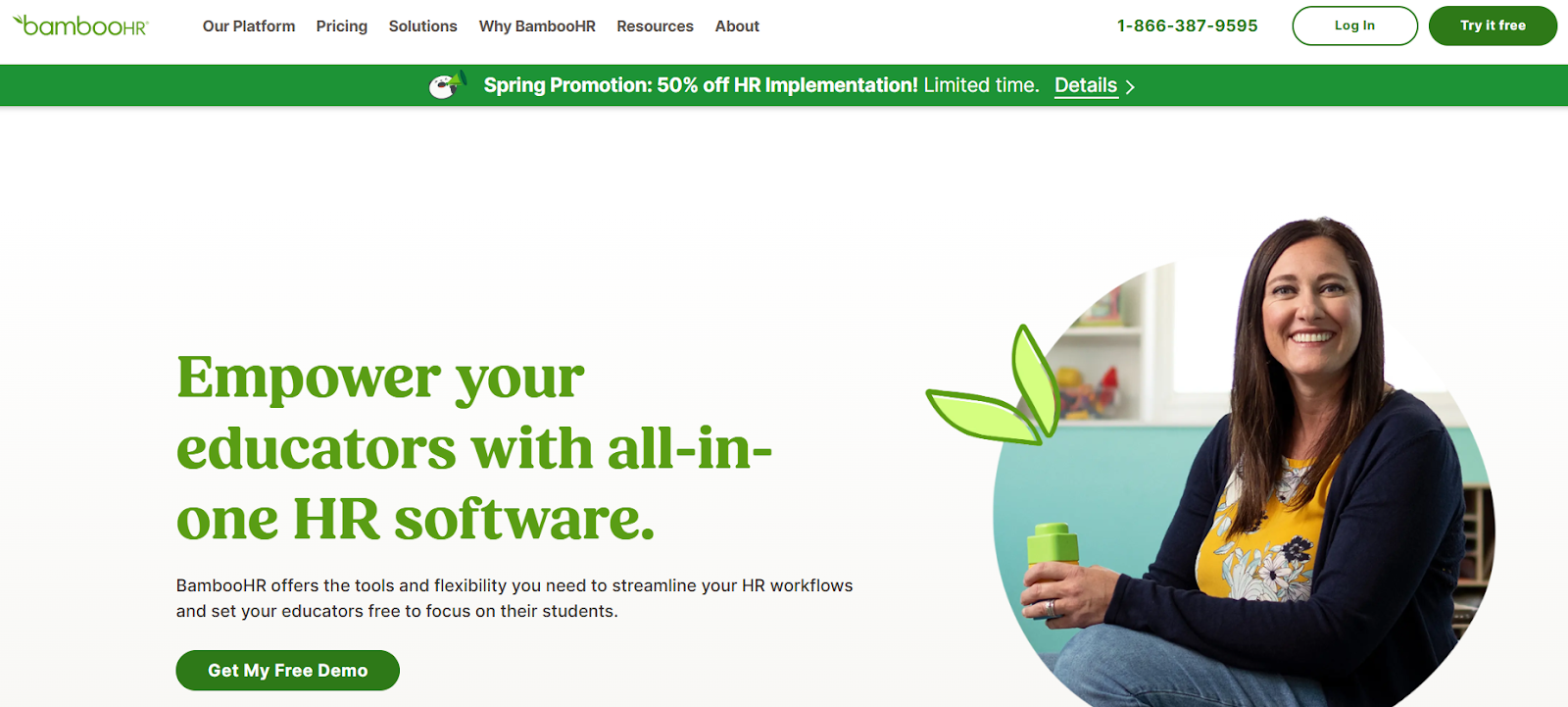
BambooHR offers a focused applicant tracking system tailored to simplify and accelerate hiring workflows of educational institutions. It helps hiring teams manage job postings, track applicants, and streamline communications within an easy-to-use interface. For schools and universities with ongoing staffing needs, BambooHR’s ATS brings structure and clarity to the recruitment process.
Features
Here are some key features of using BambooHR:
- Centralized Applicant Management: Track candidates from multiple sources in one dashboard, with real-time updates on their progress in the hiring funnel.
- Job Board Integration: Post to popular job boards like Indeed, LinkedIn, and Glassdoor directly from the platform.
- Collaboration Tools: Share notes, feedback, and ratings with your team to make collaborative hiring decisions faster and more transparent.
- Mobile Hiring App: Review applications, communicate with candidates, and manage hiring tasks on the go.
- Customizable Workflows: Set up specific hiring stages and actions to match your institution’s recruitment policies and approval processes.
Pros and Cons
Here are some pros and cons of using BambooHR:
| Pros | Cons |
| Easy-to-use ATS interface, suitable for both small and large teams. | ATS analytics and reporting could be more advanced. |
| Seamless job posting to multiple boards saves time. | Integrations with some external platforms may require workarounds. |
| Efficient collaboration tools improve internal communication. | Limited customization options for certain hiring workflows |
BambooHR is one of the most effective ATS tools in hrtech marketplace. Schedule a call today to learn more.
4. Eploy
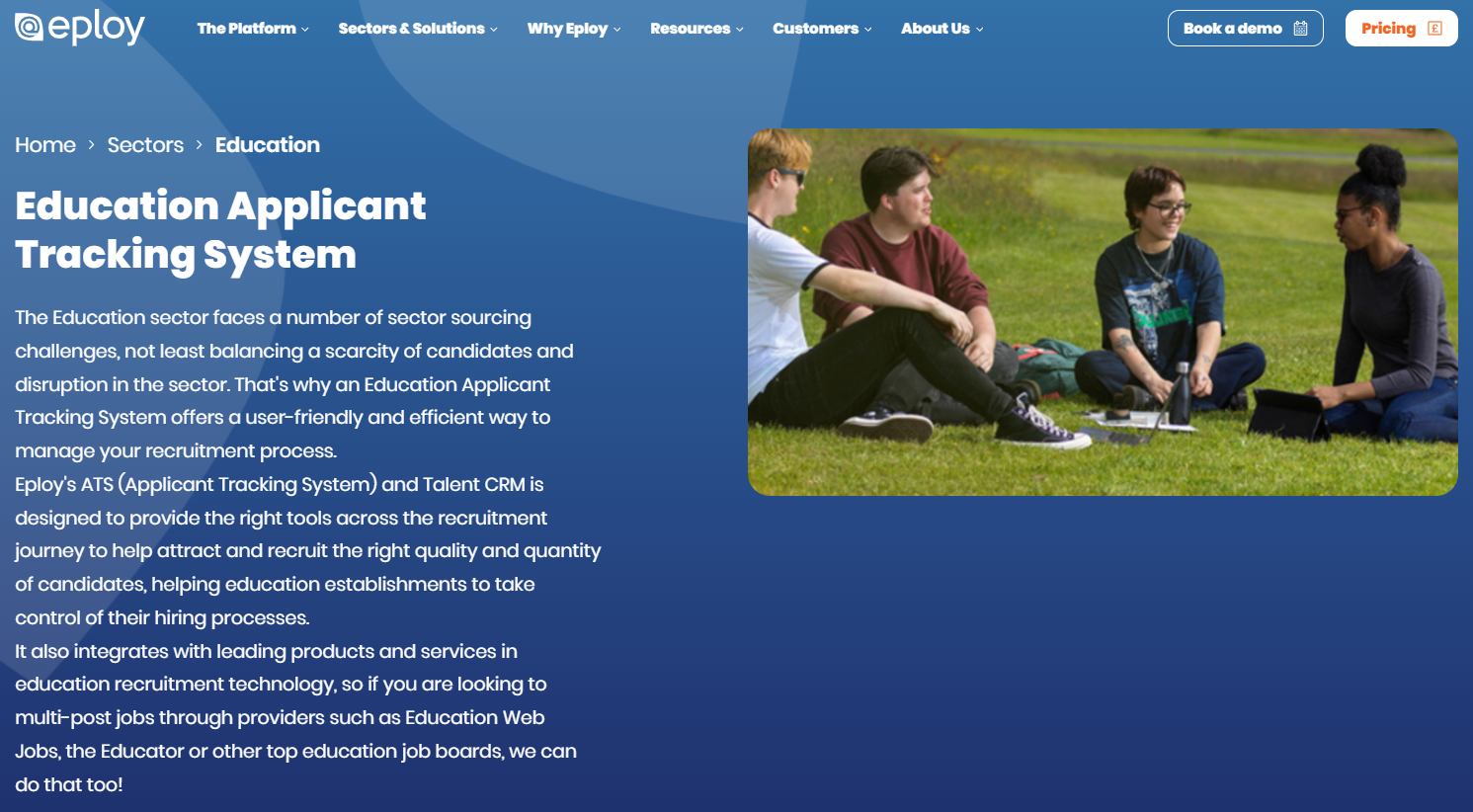
Eploy is a comprehensive applicant tracking system (ATS) designed to meet the unique recruitment needs of educational institutions. It offers a flexible and user-friendly platform that streamlines the entire hiring process, from job requisition to onboarding. Eploy integrates seamlessly with career sites to improve the candidate experience and recruitment efficiency.
Features
Here are some key features of Eploy:
- Engaging Career Sites: Eploy provides customizable career sites that attract and engage top talent, ensuring a captivating candidate experience.
- Social Media Posting: The platform enables powerful social media posting capabilities, allowing institutions to reach a broader audience across various channels.
- Interactive Hiring Manager Portal: Eploy offers an interactive portal for hiring managers, facilitating collaboration and streamlining the decision-making process.
- Candidate Screening: The system includes effective candidate screening tools to assess and shortlist applicants efficiently.
- Configurable Workflows: Eploy allows for the customization of recruitment workflows to align with the specific processes of an educational institution.
Pros and Cons
Here are some pros and cons of using Eploy:
| Pros | Cons |
| Users appreciate Eploy’s flexibility in adapting to varied organizational needs. | The extensive configurability may require a learning period for new users. |
| The system is intuitive and user-friendly for both admins and hiring managers. | Some users faced issues integrating Eploy with third-party apps. |
| Eploy’s support team is responsive and helpful. | The extensive features may be costly for smaller institutions. |
5. Teamtailor
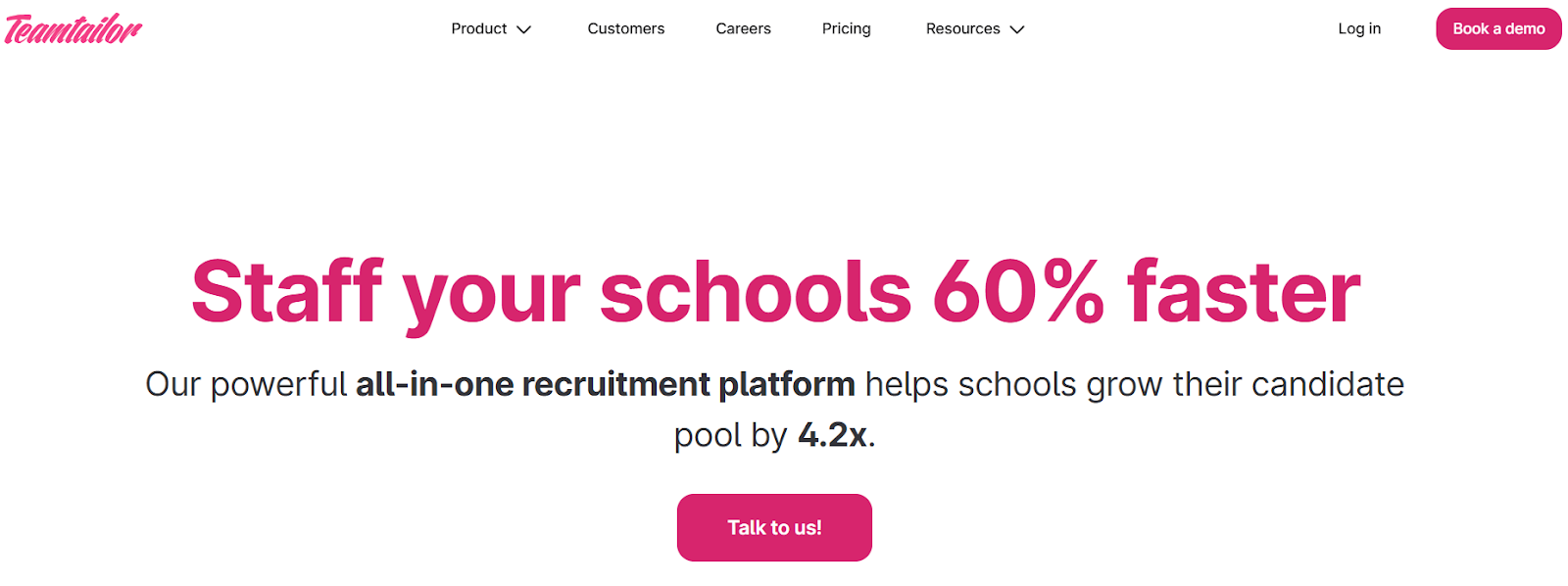
Teamtailor is an all-in-one ATS designed exclusively for the recruitment process for educational institutions. It offers a user-friendly platform that enhances candidate engagement and simplifies hiring workflows. With Teamtailor, schools can attract, nurture, and hire top talent efficiently.
Teamtailor has a rating of 4.6 out of 5 on G2.
Features
Here are some key features Teamtailor are as follows:
- Career Site Builder: Create customizable and attractive career pages to showcase your school’s culture and job openings.
- Candidate Relationship Management: Build and maintain relationships with potential candidates through personalized communication tools.
- Automated Workflows: Utilize smart triggers to automate repetitive tasks, ensuring a more efficient recruitment process.
- Analytics and Reporting: Gain insights into your recruitment funnel with comprehensive reports and analytics to identify areas for improvement.
- Mobile Accessibility: Manage recruitment tasks on the go with a fully functional mobile app, allowing for flexibility and responsiveness.
Pros and Cons
Here are some pros and cons of using teamtailor:
| Pros | Cons |
| The platform’s communication tools improve candidate interactions. | Some users desire more advanced customization options for certain features. |
| Teamtailor’s support is helpful and responsive. | Teamtailor may have limited third-party integrations. |
| Users appreciate Teamtailor’s intuitive design, making it easy to use. | Some users have reported a desire for more advanced features in specific areas. |
Also Read: “How an All-in-One Hiring Platform Can Transform Your Recruitment Strategy”.
These are some ATS tools suitable for educational institutions. However, the hiring needs and requirements for the hospitality industry are very different from the education sector. Let’s explore some unique hiring needs of the hospitality industry.
Consult an expert to learn more about the best ATS solutions for the education sector. Schedule a call today!
Unique Hiring Needs of Hospitality Industry
Hiring in the hospitality industry is guest-centric and heavily reliant on soft skills. With frequent employee turnover and high demand during peak seasons, recruitment processes need to be both agile and thorough.
Here are some unique hiring needs in the hospitality sector:
- High-volume hiring: Constant need to fill multiple positions quickly, especially during holidays and tourist seasons.
- Soft skills assessment: Emphasis on personality traits like communication, patience, and friendliness.
- Fast turnaround time: Short timelines between job posting and onboarding due to operational urgency.
- Shift-based and flexible roles: Need for candidates willing to work non-traditional hours, weekends, and rotating shifts.
- High turnover management: Processes must be efficient to handle frequent exits and re-hires.
- Brand representation: Employees are often the “face” of the brand and must align with its image and values.
- Multilingual capabilities: Preference for candidates who can speak multiple languages, especially in global tourist hubs.
- Compliance and certification checks: Requirement to verify training, health, and safety certifications, depending on the role.
Also Read: “How Technology is Transforming Blue-Collar Recruitment”.
Based on these unique hiring needs, we have compiled a list of the ATS platforms that are suitable for hiring in the hospitality sector.
5 Best Applicant Tracking Solutions for Hospitality
1. Greenhouse ATS
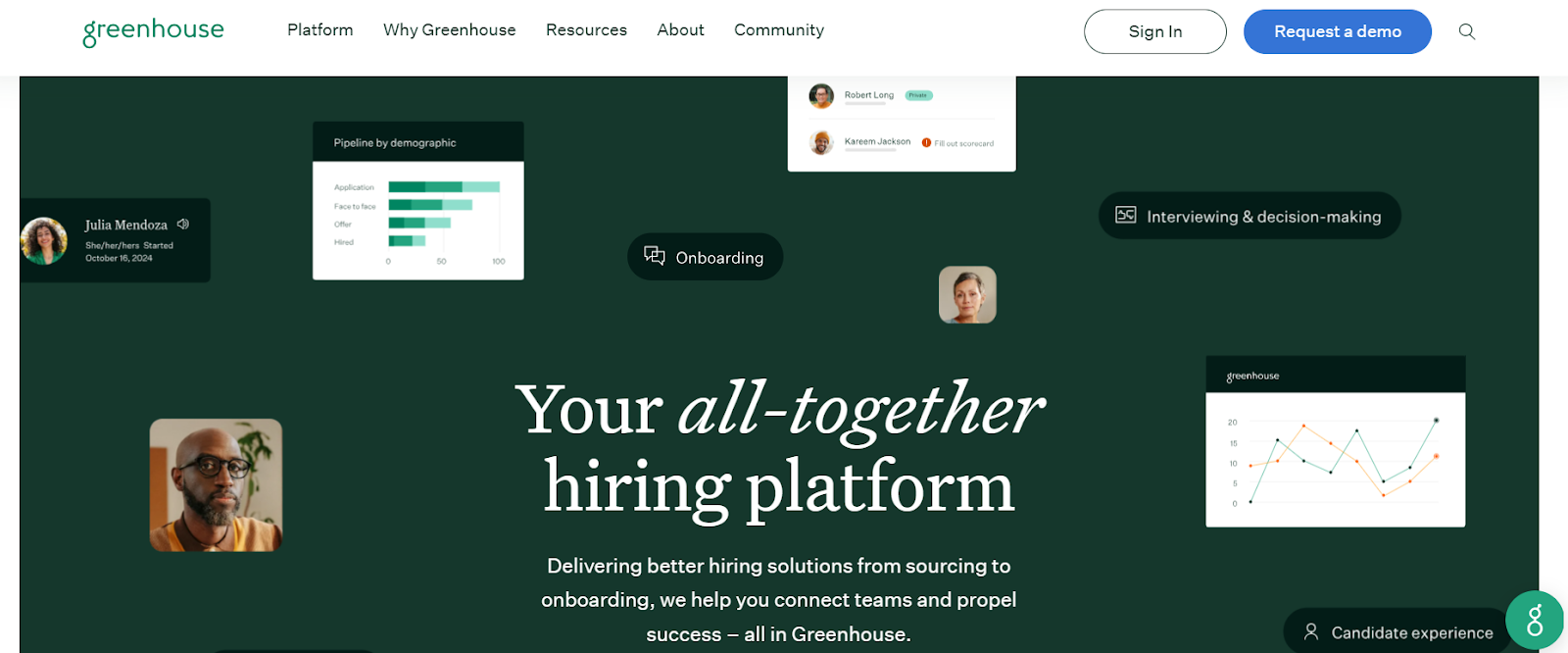
Greenhouse is an ATS and hiring platform designed to optimize the recruitment process for organizations across various industries, including hospitality. Its structured approach to hiring ensures that businesses can efficiently attract, evaluate, and onboard top talent. While Greenhouse offers all-in-one HRM solutions, its ATS is remarkable for hiring from a large talent pool.
Greenhouse has a rating of 4.4 out of 5 on G2.
Features
Here are some features of Greenhouse:
- Structured Hiring Process: Greenhouse emphasizes a systematic approach to recruitment, ensuring consistency and fairness in candidate evaluations.
- Job Board Syndication: The platform allows seamless posting to multiple job boards, expanding the reach to potential candidates.
- Interview Scheduling: Greenhouse offers tools to coordinate and schedule interviews efficiently, reducing administrative overhead.
- Reporting and Analytics: Provides insights into recruitment metrics, aiding in data-driven decision-making.
- Onboarding Integration: Facilitates a smooth transition from candidate to employee with integrated onboarding features.
- Diversity, Equity, and Inclusion (DE&I) Tools: Provides features to mitigate bias, promoting fair and equitable hiring practices.
Pros and Cons
Here are the pros and cons of using Greenhouse:
| Pros | Cons |
| Helps in collaborative hiring, useful when multiple managers assess candidates. | Some users find workflow customization limited for niche or seasonal hiring. |
| Built-in tools reduce bias, supporting more inclusive hiring. | Setup can be time-consuming without a dedicated HR tech team. |
| Structured templates aid in evaluating soft skills for customer-facing roles. | Smaller businesses may find the features excessive or overwhelming. |
2. iCIMS
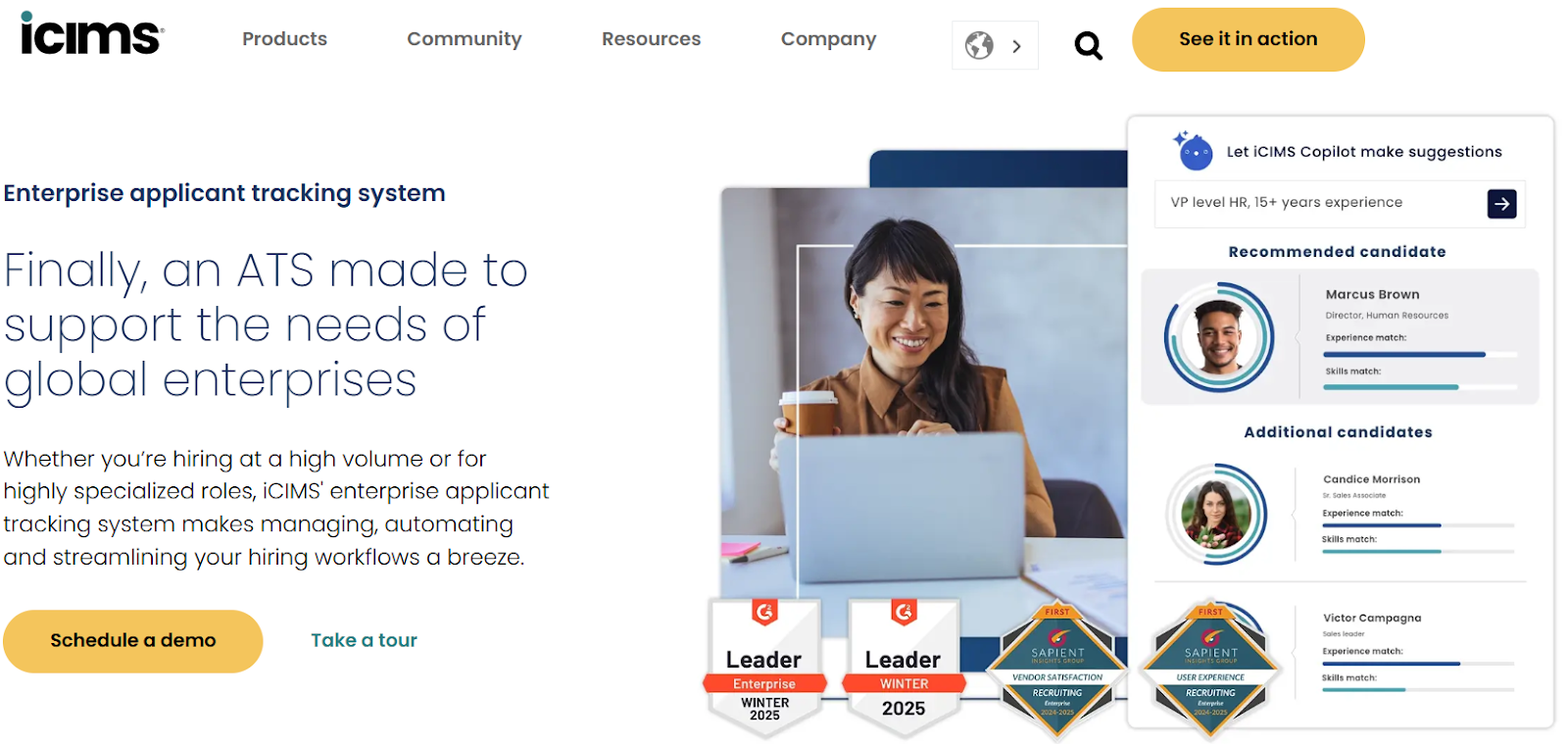
iCIMS is a comprehensive ATS designed to streamline the hiring process for organizations of various sizes. Its robust platform offers a suite of tools aimed at improving recruitment efficiency and improving candidate experiences.
iCIMS has a rating of 4.1 out of 5 on G2.
Features
Here are some key features of iCIMS:
- AI-Powered Candidate Matching: Utilizes artificial intelligence to surface best-fit candidates for newly created jobs, automating suggestions for recruiters and hiring managers.
- Automated Interview Scheduling: Reduces manual scheduling efforts by allowing candidates to self-schedule interviews, integrating with calendars like Office365 and Google Calendar.
- Candidate Relationship Management (CRM): Offers tools to track and organize candidates across mobile, digital, and social media platforms, facilitating effective engagement.
- Employer Branding Tools: Provides features to optimize employer branding on career sites, job portals, and employee testimonial pages, enhancing the organization’s appeal to potential candidates.
- Comprehensive Reporting and Analytics: Enables the creation of detailed reports on various recruitment metrics, aiding in data-driven decision-making.
Pros and Cons
Here are some pros and cons of using iCIMS:
| Pros | Cons |
| Users value its flexibility and customizable workflows. | Some users find setup time-consuming and resource-intensive. |
| Integrates well with systems like UKG to streamline hiring and onboarding. | Some users find the interface less intuitive, with a steeper learning curve. |
| The reporting tools offer detailed, comprehensive recruitment insights. | The pricing structure may be a concern for smaller organizations with limited budgets. |
3. Hireology
In the hospitality sector every open role can impact guest experience, Hireology is a powerful ATS and offers all the features suitable for recruitment in the hospitality sector. It’s not just another ATS — it’s a purpose-built solution for businesses juggling multiple locations, seasonal hiring, and high turnover. With tools that go beyond job posting, Hireology helps hospitality teams turn complex hiring into a smooth, repeatable process that actually works.
Hireology has a rating of 4.5 out of 5 on G2.
Feature
Here are some features of Hireology:
- Customizable Workflows: Tailor each step of the hiring process to align with unique organizational needs.
- Interview Guides and Scoring: Hireology offers structured interview templates and scoring systems to ensure consistent candidate evaluations.
- Built-in Candidate Verification: You can conduct background checks and reference verifications directly within the platform.
- In-app Candidate Communication: Hireology helps you easily communicate with candidates through integrated messaging features.
- Task and Communication Automation: Automate repetitive tasks and communications to enhance efficiency and reduce time-to-hire.
Pros and Cons
Here are some pros and cons of using
| Pros | Cons |
| The structured interview templates help maintain consistency across interviews. | There can be difficulties integrating Hireology with third-party applications. |
| The support team is noted for being helpful and responsive to user inquiries. | Some users desire more flexibility in creating customized reports. |
| Users find the platform intuitive and easy to use, simplifying the hiring process. | The pricing may be a concern for smaller hotels with limited budgets. |
4. JazzHR
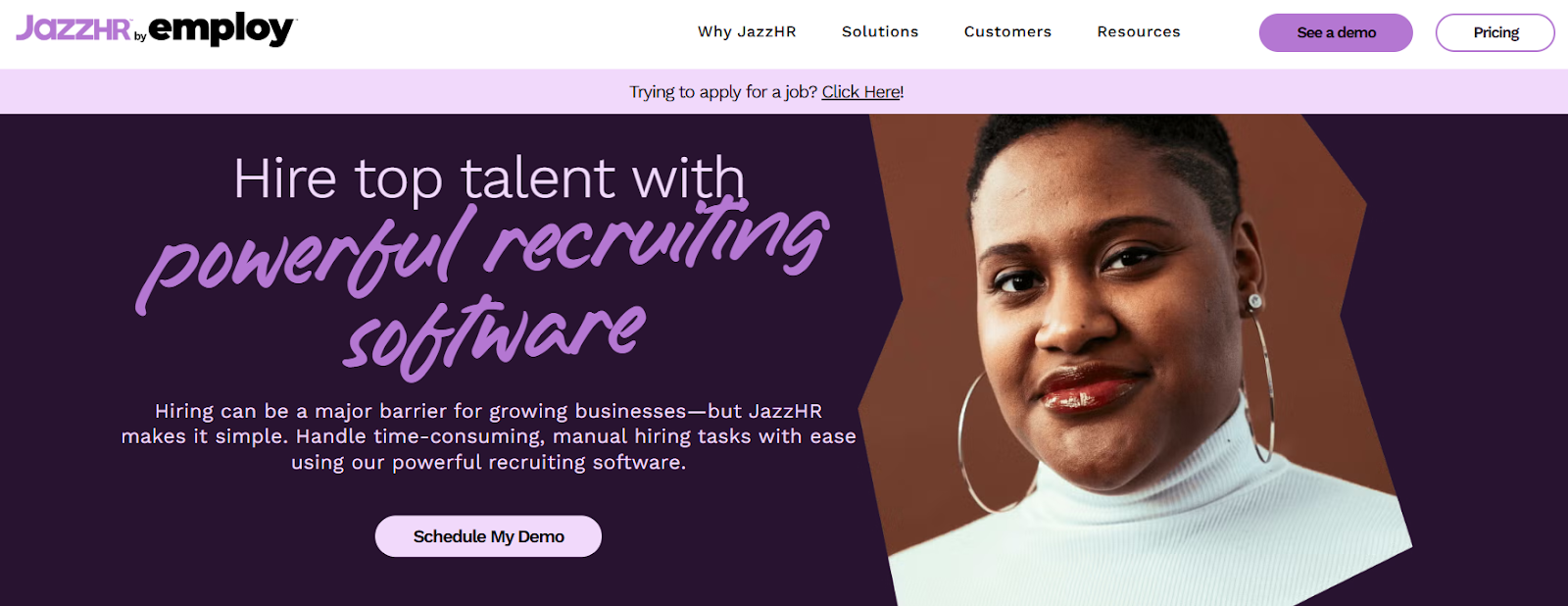
JazzHR is a user-friendly applicant tracking system tailored for small and growing businesses, including those in the hospitality industry. It helps in the hiring process by automating tasks and centralizing candidate information, enabling teams to attract, screen, and hire top talent efficiently.
JazzHR has a rating of 4.4 out of 5 on G2.
Features
Here are some key features of JazzHR:
- Customizable Workflows: JazzHR allows businesses to tailor each step of the hiring process to align with their unique needs, ensuring a personalized recruitment experience.
- Collaborative Hiring: The platform facilitates team collaboration by enabling the inclusion of key teammates in the recruiting process from the start, increasing the likelihood of making great hires.
- Automated Resume Parsing: JazzHR analyzes resumes and applicant data based on user-selected preferences, streamlining the candidate evaluation process.
- Interview Scheduling Integration: The system integrates with calendars, allowing seamless scheduling of interviews and reducing administrative overhead.
- Reporting and Analytics: JazzHR provides analytics tools that reveal important business metrics and track progress, aiding in data-driven decision-making.
Pros and Cons
Here are some pros and cons of using JazzHR:
| Pros | Cons |
| JazzHR’s resume parsing and filters help hospitality managers handle seasonal applicant surges. | JazzHR posts widely, but may miss quality candidates for niche hospitality roles. |
| Pre-built templates assist in assessing soft skills vital for hospitality roles. | Lacks features like multilingual support, making it less suited for international chains. |
| JazzHR’s simple tools help small hotels and restaurants stay organized. | Rapidly growing businesses may find JazzHR less adaptable. |
5. Gusto
Gusto’s applicant tracking system brings simplicity to what’s often a chaotic process, helping restaurants and hotels hire quickly without sacrificing quality. Unlike generic HR tools, Gusto focuses on what hospitality teams need most: speed, clarity, and ease of use.
Gusto has a rating of 4.5 out of 5 on G2.
Features
Here are some key features of using Gusto:
- Multi-Site Job Posting: Post openings for multiple restaurant branches, hotels, or event venues across major job boards like LinkedIn and Indeed.
- Centralized Applicant Dashboard: Manage applications for various hospitality roles (front desk, kitchen staff, housekeeping, etc.) through a single, streamlined interface.
- Custom Hiring Pipelines: You can create stages for different roles—like trial shifts, skill tests, or panel interviews—based on the unique requirements of hospitality positions.
- Built-In Offer Letters & e-Signatures: You can speed up hiring by sending offer letters, collecting signatures, and storing documents.
- Automatic Reminders & Status Updates: Keep hiring managers and candidates in sync with built-in alerts, interview reminders, and status tracking, especially useful during high-volume recruitment.
Pros and Cons
Here are some pros and cons of using Gusto:
| Pros | Cons |
| Hospitality recruiters can fill roles faster by broadcasting listings to multiple boards at once. | larger hospitality enterprises with hundreds of hires per month may find the ATS features too basic. |
| Non-HR staff can easily track and manage applicants. | Lacks robust reporting for hiring trends or candidate source performance. |
| Ideal for rapid onboarding of seasonal or hourly staff, with templates and digital forms. | May lack customization for strict cross-department access controls. |
Now that we have discussed some of the leading ATS tools for hospitality, let’s understand how to choose the right tool for both the education and hospitality sector.
Schedule a call with hrtech today for personalized guidance on the best ATS solutions for the hospitality sector.
How to Choose the Right Applicant Tracking System?
An ATS is only effective when it aligns with the unique demands of your sector. Whether you’re managing recruitment in a school district or staffing a hotel chain, the right solution should support your workflows.
Below, we break down what to prioritize when selecting an ATS for the education and hospitality industries.
What to Look for in an ATS for Hiring in the Education Sector?
Hiring in education comes with a unique set of challenges. For instance strict compliance requirements and the need for specialized academic roles are some of the unique challenges that you may face as a hiring manager in the education sector.
When choosing an ATS for educational institutions, consider the following:
- Role-Based Workflows: Look for customizable hiring pipelines that can accommodate different staff categories—teachers, support staff, administrative roles, etc.
- Integration with HRIS & Payroll: Ensure the ATS integrates with existing HR and payroll systems commonly used in education settings.
- Compliance and Documentation: Choose a tool that supports secure document storage, background check tracking, and other compliance needs in line with state or institutional regulations.
- Collaboration Features: Institutions often involve multiple stakeholders in hiring. Opt for an ATS that enables shared evaluations, comment threads, and approval routing.
- Academic Calendar Support: An ideal ATS should accommodate cyclical hiring patterns aligned with school terms and semesters.
What to Look for in ATS for Hiring in the Hospitality Sector?
In hospitality, speed and volume define the recruitment process. Whether it’s filling roles for a new opening or managing high turnover during peak seasons, here’s what a hospitality-focused ATS should offer:
- High-Volume Applicant Management: Look for platforms that can handle a large influx of applications without slowing down or compromising on filtering options.
- Multi-Location Support: If you’re operating across several restaurants, hotels, or event venues, choose an ATS that allows location-based job posting and candidate tracking.
- Mobile Accessibility: Hiring managers in hospitality are often on the move. A mobile-friendly interface ensures you can review candidates or schedule interviews from anywhere.
- Quick Onboarding Tools: Speed matters—especially when hiring hourly or seasonal staff. Prioritize ATS platforms with integrated onboarding features like e-signatures and digital forms.
- Ease of Use: With limited time for training, a simple, intuitive design helps managers adopt the system quickly without steep learning curves.
Also Read: “Top Important Features of Applicant Tracking Systems”.
Conclusion
Choosing the right applicant tracking system is essential for streamlining recruitment in both education and hospitality. From managing seasonal hiring to meeting compliance needs, the right ATS can simplify every stage of the hiring process. This blog covered top ATS solutions for each sector, along with key features to help you choose wisely.
If you’re looking for the best ATS platforms, hrtech is a widely trusted platform where you can find the best ATS tools. You can choose from a wide range of tools or schedule calls for personalized support in choosing the right solution. Relevance of the ATS to the industry is crucial, and hrtech offers ATS solutions by taking unique needs of all industries into consideration.
Need help finding the best ATS for your organization? Connect with hrtech today and make hiring smarter, faster, and more effective.

